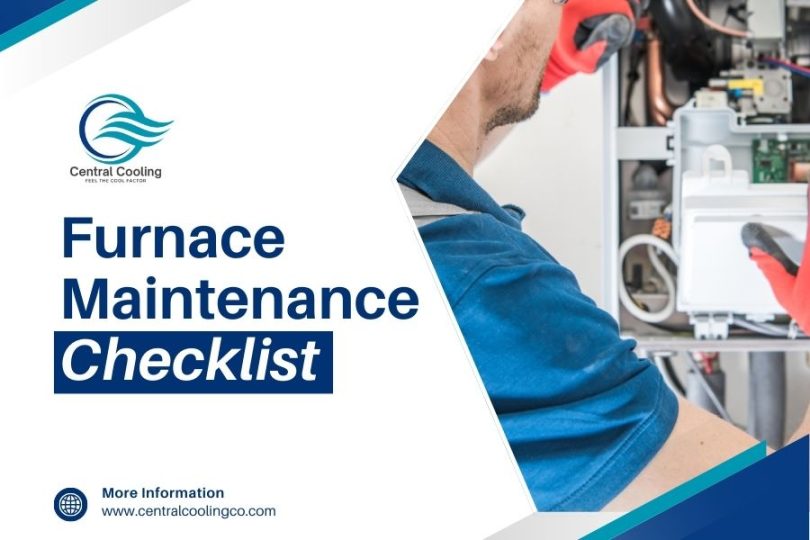As a diligent homeowner, ensuring the longevity and efficiency of your home furnace is crucial for maintaining a comfortable living environment. Regular furnace maintenance tips play a pivotal role in achieving this goal. In this comprehensive guide, we will delve into the furnace maintenance checklist which includes essential steps for inspecting and repairing your furnace to keep it operating smoothly throughout the year.
A well-maintained furnace not only enhances comfort but also contributes to energy efficiency and indoor air quality. By following a structured furnace maintenance routine, you can prevent costly repairs and ensure that your heating system operates reliably when you need it most. Let’s explore the key tasks involved in maintaining your furnace to help you navigate the seasons with confidence and peace of mind.
Furnace Maintenance Checklist – 7 Easy Steps
A well-rounded furnace maintenance shedule involves a series of tasks that should be performed at least once a year. However, the replacement of the air filter is an exception, requiring attention every three months or more frequently if necessary. Here’s a breakdown of the key maintenance checklist:
1. Replace Air Filter
The air filter in your furnace serves to eliminate dirt, dust, and impurities from the air. It should be replaced every three months, with more frequent replacements (every 1-2 months) for pleated filters. Non-pleated filters are suitable for older HVAC systems, lasting approximately a month without significantly restricting airflow.
How to Replace the Furnace Air Filter:
– Turn off the furnace.
– Remove the filter access panel.
– Gently replace the old filter with a new one, ensuring proper airflow direction.
2. Clean Burners And Flame Sensor
Inspecting and cleaning the furnace burners is crucial for efficient combustion. Remove the cover plate, vacuum around the burners, and clean the burner assembly, especially the front where the flame emerges. Take caution while cleaning the flame sensor to avoid damage.
3. Inspect Heat Exchanger And CO Detector
While most heat exchanger maintenance is best left to professionals, you can perform regular inspections. Look for signs of damage, excessive rust, or carbon buildup. Conduct a heat exchanger match test to detect airflow abnormalities.
4. Lubricate Blower And Inducer Fans
Ensure smooth rotation of the furnace blower by checking for any obstacles. Lubricate the blower motor regularly, focusing on older fan motors with oil ports. Verify the condition of belts, pulleys, and V-belts, replacing them if necessary.
5. Clean Humidifier
If your HVAC system includes a humidifier, ensure it is clean and functional. Adequate humidity is essential for a comfortable indoor environment and helps prevent dry skin, allergies, and respiratory issues.
6. Inspect Electrical Wirings And Controls
Inspect all electrical connections for tightness and signs of wear. Clean the electrical enclosure area to remove dirt and ensure proper functioning. Address loose wires and rusted connectors promptly to avoid erratic behavior or fires.
7. Check Thermostat For Proper Operation
Verify that the thermostat operates correctly, checking fan speeds and the functionality of valves and dampers. Use a portable temperature sensor to ensure the thermostat reads the correct temperature.
Furnace Air Filter Maintenance
The furnace air filter plays a crucial role in maintaining indoor air quality by trapping dirt and impurities. Regular replacement ensures optimal performance and prevents airflow restrictions. Follow these steps to replace the air filter:
1. Turn off the furnace: Before replacing the air filter, ensure the furnace is switched off for safety.
2. Remove filter access panel: Locate the filter access panel on the furnace and remove it to access the filter.
3. Replace the old filter: Gently remove the old filter, taking care to avoid spreading dust and grime. Insert the new filter into the filter chamber. If the filter has an arrow, ensure it points in the same direction as the furnace airflow.
Regular air filter replacement contributes to a cleaner and healthier indoor environment, promoting efficient furnace operation.
Maintenance of A Furnace Burner
The furnace burner is responsible for burning gas to produce a flame, making it a critical component for efficient combustion. Regular inspection and cleaning of the burner assembly are essential to ensure its proper functioning. Follow these steps for burner maintenance:
1. Turn off power and gas: Before inspecting the burner, cut off power and gas to the furnace for safety.
2. Remove cover plate: Access the interior of the furnace by removing the cover plate.
3. Vacuum around burners: Clear the area around the burners of any debris using a vacuum.
4. Inspect and clean burners: Remove the burners and inspect the front where the flame emerges. Use a brass wire brush to brush away any debris.
5. Check transition vanes: Some burners have “transition vanes” on the sidewalls, allowing the flame to flow from burner to burner. Ensure these vanes are clean to prevent issues with burner firing.
Exercise caution when working with the igniter, especially if it’s a hot surface igniter. If the igniter is not working, consider replacing it for optimal performance.
Maintenance Of The Furnace Burner Manifold
The burner manifold is responsible for injecting fuel into the burners, and it consists of small apertures that can become clogged. Regular cleaning is essential to prevent blockage and maintain efficient fuel flow. Follow these steps for burner manifold maintenance:
1. Inspect the manifold: Locate the burner manifold in the furnace and inspect it for any signs of blockage.
2. Clean small apertures: Use a small wire or paperclip to clean the small apertures in the burner manifold. Ensure that no material is obstructing the flow of gas.
Regular maintenance of the burner manifold ensures consistent and efficient fuel injection into the burners.
Cleaning The Furnace Flame Sensor
The flame sensor is a critical component that ensures all burners ignite properly. A dirty flame sensor can lead to the furnace shutting down even if all burners are lit. Regular cleaning of the flame sensor is essential for uninterrupted furnace operation. Follow these steps for flame sensor maintenance:
1. Disconnect and remove the flame sensor: Turn off the furnace and disconnect the flame sensor. Remove it for cleaning.
2. Clean the metal rod: Use a brass wire brush, rag, or scouring pad to clean the metal rod and eliminate any char buildup. Exercise caution to avoid scratching or damaging the sensor’s ceramic body.
3. Replace the flame sensor: After cleaning, place the flame sensor back in its position and secure it with a screw.
Cleaning the flame sensor contributes to a more reliable and efficient furnace operation, preventing unnecessary shutdowns.
Inspection of The Furnace Heat Exchanger
While most heat exchanger maintenance is best left to professionals, regular inspections can help identify potential issues. The heat exchanger is a critical component for efficient heating, and any signs of damage, rust, or carbon buildup should be addressed promptly. Follow these steps for heat exchanger inspection:
1. Cut off power and gas: Ensure the furnace is switched off by cutting off power and gas.
2. Remove access panel: Open the access panel to gain access to the furnace’s mechanical components.
3. Examine heat exchange cells: Inspect the heat exchange cells behind the burners for damage, excessive rust, or carbon buildup. Remove the burner or fan if necessary for a closer examination.
4. Use inspection cameras or endoscopes: In tight spaces, use inspection cameras or endoscopes to detect ordinarily unseen cracks in the heat exchanger.
While regular inspections are beneficial, any significant issues with the heat exchanger may require professional assistance. Cracked heat exchangers can be expensive to replace, and consulting with a local HVAC professional is recommended to explore available options.
Heat Exchanger Matching Test
The heat exchanger matching test is a practical method for detecting cracks in your heat exchanger. By observing airflow from the heat exchanger fans, this test aids in identifying damaged heat exchangers. Follow these steps for the heat exchanger matching test:
1. Set furnace to FAN ONLY mode: Ensure the furnace is in FAN ONLY mode and not in AUTO or HEAT mode.
2. Turn off the gas supply: While inspecting the heat exchanger, turn off the furnace’s gas supply.
3. Use matches for the test: Light matches and place them in front of the heat exchanger cells while the furnace fan is running.
4. Observe match flames: Be cautious of match flames and observe their behavior. If the wind blows and stops the matches, it indicates a crack or hole in the heat exchanger.
This test works based on the principle that the air from the fan blows out the matches through any openings in the heat exchanger. If any irregularities are detected, it is crucial to address them promptly to ensure the safe and efficient operation of the furnace.
The Detector Of Carbon Monoxide
A faulty heat exchanger poses serious risks, as poisonous gases may leak into the airflow in your home. Installing carbon monoxide (CO) alarms is crucial for the safety of residents. Follow these guidelines for proper CO detector maintenance:
1. Install CO alarms: Install at least one CO alarm on each floor and in each bedroom in your home. For enhanced safety, install alarms on the ceiling or high on the wall.
2. Test CO alarms regularly: Conduct regular tests of the CO alarm, preferably at least once a month, to ensure proper functionality.
3. Replace batteries: Replace the batteries in your CO detector every six months, even if they seem to be functioning well. Keep in mind that CO detectors typically need replacement after 5-7 years.
4. Note installation date: Keep track of the installation date of your CO alarm to determine when a replacement is necessary.
Carbon monoxide is heavier than air, so CO detectors can be easily wall-mounted. Regular testing and maintenance of CO alarms are essential for detecting potential issues and ensuring the safety of occupants. Learn more about furnace carbon monoxide leaks.
Maintenance of A Furnace Blower
The furnace blower plays a crucial role in circulating air throughout your home, ensuring the even distribution of heat. Regular maintenance of the blower motor, fan blades, belts, and pulleys is essential for optimal performance. Follow these steps for furnace blower maintenance:
1. Turn off furnace power: Switch off the power to the furnace before performing any maintenance on the blower.
2. Open furnace access panel: Gain access to the blower by opening the furnace access panel.
3. Check fan wheel rotation: Ensure that the fan wheel rotates freely and smoothly without any obstructions.
4. Inspect fan blades: Check the condition of the fan blades, ensuring they are not dusty or broken.
5. Examine belts and pulleys: Verify the condition of belts and pulleys, ensuring the V-belt is in good shape and appropriately tensioned. V-belts typically have a lifespan of around a year.
6. Lubricate the blower motor: Regularly lubricate the blower motor to maintain smooth operation. Older fan motors may have oil ports that can be filled with a suitable lubricant.
7. Check newer fan motors: For newer fan motors lacking oil ports, oil must be delivered directly to the motor shaft connected to the body.
Regular maintenance of the furnace blower ensures efficient air circulation and contributes to the overall performance of the HVAC system.
Furnace Inducer Upkeep
The inducer is a critical component that expels combustion gases from the furnace. Regular maintenance checks ensure the inducer’s safety and functionality. Follow these steps for furnace inducer upkeep:
1. Turn off the furnace: Before servicing the inducer, switch off the power to the furnace.
2. Remove access panel: Open the furnace access panel to reveal the inducer.
3. Check inducer motor: Ensure the inducer motor is secure and not loose. Some inducer motors may have grommets for added stability.
4. Inspect cooling blades: If the induction motor has cooling blades, rotate them to check if the motor freely rotates. A dragging or stuck motor may indicate a malfunction and should be addressed promptly.
5. Lubricate induction motor: If the inducer motor becomes stuck, lubricating it can help restore smooth rotation. Older induction motors may have oil ports for easy lubrication.
6. Inspect bleed port: Ensure the bleed port, also known as the bleed boot, is tightened and secure. A leak in the breather boot could allow combustion gases into your home.
Regular maintenance of the furnace inducer ensures the safe expulsion of combustion gases and contributes to the overall safety of the HVAC system.
Furnace Humidifier Upkeep
A furnace humidifier adds moisture to the air in dry environments, contributing to a comfortable indoor environment. Regular maintenance of the humidifier ensures optimal performance. Follow these steps for furnace humidifier upkeep:
1. Locate the humidifier: Identify the location of the furnace humidifier in your HVAC system.
2. Check for cleanliness: Ensure the humidifier is clean and free from dust or debris.
3. Inspect water supply: Verify that the water supply to the humidifier is functioning correctly.
4. Adjust humidity settings: Adjust the humidity settings on the humidifier based on your preferences and the desired indoor humidity level.
Regular maintenance of the furnace humidifier promotes a comfortable indoor environment and helps prevent issues related to dry air.
Furnace Electrical And Controls Upkeep
While most electrical maintenance should be left to professionals, there are steps homeowners can take to ensure the electrical and control systems of the furnace are in good working order. Follow these steps for furnace electrical and controls upkeep:
1. Turn off electricity: Before working on the furnace’s electrical system, turn off all electricity to the furnace.
2. Open access panel: Open the access panel for the electrical and control wiring in the furnace.
3. Check for loose connections: Inspect all electrical connections for tightness, ensuring there are no loose wires or rusted connectors.
4. Clean electrical enclosure: Use compressed air or canned air to clean the electrical enclosure area, removing dirt and ensuring proper functioning.
5. Ensure cleanliness: Ensure that electrical components and cables are clean and free of dirt and bugs. Excessive dirt can lead to short circuits and damage to the system.
After cleaning the furnace’s electrical system, replace the access panel and turn on the furnace. If there are any concerns about the electrical or control systems, it is advisable to consult with an HVAC professional for further inspection and assistance.
Testing Of The Furnace Thermostat
The thermostat is a critical component of the furnace, regulating temperature and ensuring optimal operation. Regular testing of the thermostat helps identify any issues and ensures proper functionality. Follow these steps for testing the furnace thermostat:
1. Check fan speeds: Verify that all fan speeds are operational, especially when using multi-speed fans.
2. Inspect valves and dampers: Check the operation of valves and dampers to ensure they function correctly.
3. Use a temperature sensor: Use a portable temperature sensor to check that the thermostat reads the correct temperature. The thermostat should display the same temperature as the temperature sensor (within 1 degree Fahrenheit or 0.5 degrees Celsius).
Conclusion: Furnace Maintenance Checklist
In conclusion, this exhaustive guide transcends the routine chore of furnace maintenance; it becomes a holistic approach to home well-being. By dedicating time and attention to each facet of your furnace, you not only enhance its performance but also gain a deeper understanding of your home’s heating system. Empowered with this knowledge, you can make informed decisions, address issues proactively, and, when needed, collaborate effectively with HVAC professionals.
As seasons change and temperatures fluctuate, a well-maintained furnace stands resilient, ready to provide comfort and warmth. Consider this guide your roadmap to furnace longevity and efficiency, ensuring that your home remains a haven of warmth, safety, and tranquility throughout the year.
Disclosure: We may get commissions for purchases made through links in this post.








